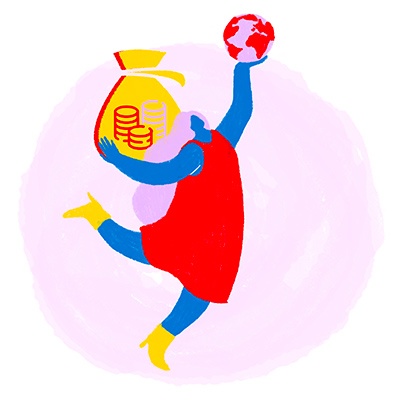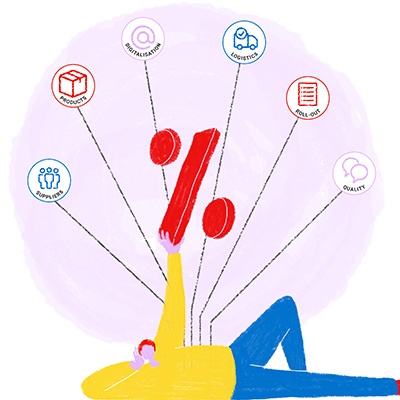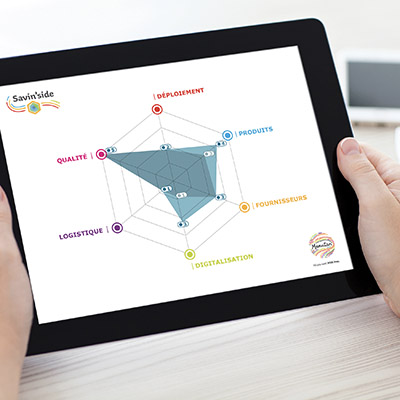When discussing the procurement function, the word "customer" often echoes internal customers within the company. However, procurement teams also help improve the end customer journey through the product or service sold. To achieve this, they clearly align their strategy with the company’s as a whole, and their missions evolve over time. A leading force, they play an essential role in keeping the company competitive and ensure its constant growth.
The customer journey, a global experience
The customer journey refers to all the stages that a customer (or prospect) passes through when interacting with a company to achieve their various objectives. This includes purchasing a product or service, getting information…
The customer journey covers a set of "moments of truth" upstream and downstream of the purchase phase, which is a global experience. Nowadays, the customer journey follows an omnichannel approach. The customer often uses multiple channels and contact points to achieve their objective, whether online (email, website, blog, social networks) or offline (physical shop, paper catalogue, mail, etc.).
To deliver tailored customer experiences and improve the customer journey step by step, companies must acknowledge current trends and consider all of the customer’s feelings, whether they’re positive or negative, during this 8-step process.
The search for information
Clients start by searching for information when they’re looking to fulfil their needs. They go online and look at items and other marketing resources about a number of products and services that could solve their problem.
Comparison
The customer conducts further research by looking more closely at the following items of information:
- Features;
- Prices;
- Guarantees;
- Associated services;
- Etc.
Then they compare different options online or in a shop to identify which one best meets their needs.
Decision-making
Having considered every angle, the customer now makes a choice. This decision is based on the previous steps. They choose to buy the product or service via the appropriate channel.
Reception
The customer tries out the product or service purchased for the very first time. They expect the company to provide them with easy-to-understand instructions (a video guide, for example) about how to install, assemble and use it.
Evaluation
Once they have used the product or service a few times, the customer evaluates how they feel about it. They can also leave their feedback by completing surveys. These make it easy for companies to measure customer satisfaction: They can use this data to identify the areas they need to focus on improving. This analysis then brings new and better business opportunities.
Customer service
If there is a problem with the product or service following the purchase, clients get in contact the company’s customer support team. To increase user satisfaction and build loyalty, its is crucial that the customer is offered a solution to the problem as quickly as possible through polite conversations. The aim to reduce the risk of customers being dissatisfied. To this end, they can use digital tools such as an automated live chat platform, for example.
Building customer loyalty
The customer forms an opinion on the company’s overall performance based on this experience. They then decide whether or not they wish to keep their commercial relationship with the brand. This phase is thus critical.
Recommendation
This is the last stage of the customer journey. If the overall experience is a success, the customer becomes an ambassador for the company. It means they can recommend it to their network (on social media, for example) and increase their NPS (Net Promoter Score). To cultivate their relationship with their most loyal customers, companies can invite them to events or offer them discounts on some of their products.
The procurement function’s levers for improving the customer journey
In an increasingly complex economy where there are multiple information flows and customers are more and more demanding, the procurement function’s roles are changing.
Historically, buyers have always focused on costs, risks, and quality through supplier negotiations. These are all essential elements that improve the customer journey during the key stages of comparison, decision-making and loyalty.
Procurement costs are reflected in the selling price: Risks influence the availability of the product and/or service and quality has an important impact on customer satisfaction in the long term.
However, buyers are now focusing on creating value for end customers. Procurement has several optimisation levers at its disposal for achieving this, namely innovation, sustainable development, and supplier relations.
Capturing innovation
Firstly, procurement departments help reinvent their company’s business model. For that, they must capture innovation from their existing suppliers or integrate new ones. It is through sourcing innovations (digital solutions, raw materials, etc.) that a company can help create the products and services of the future.
Integrating CSR issues
If they want to accelerate their company’s ability to stand out from the crowd, procurement departments must also deploy a sustainable procurement policy. To do so, they need to implement tangible CSR (corporate social responsibility) actions. Businesses that incorporate sustainable development and ethics throughout their value chain are able to offer quality products or services that set them apart, while responding to issues that are currently at stake in our society.
Strengthening relationships with key suppliers
It will not be the first time you have heard it but supplier relationships and the associated balance of power are slowly turning around. With the disruption of technology and raw materials, companies now need to do their utmost to become their strategic suppliers’ "favourite customer". Transparency, collaboration, and agility are the watchwords.
Through these new powerful levers of action, procurement departments can expect to play an even more decisive role in the customer journey, particularly during the decision-making and loyalty process. It is only through innovative, sustainable products and services, with total control over the value chain, that companies can hope to surpass the expectations of their target and thus considerably improve the customer journey.
- If you want to find out more, download our white paper on Lean Procurement









